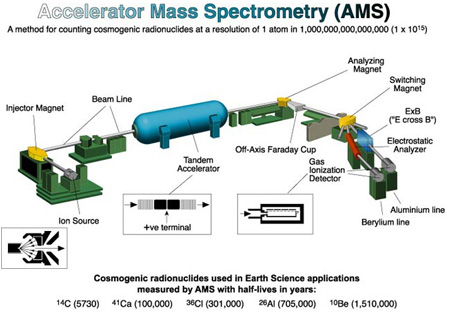Accelerator Mass Spectrometry

- There are essentially two parts in the process of radiocarbon dating through accelerator mass spectrometry. The first part involves accelerating the ions to extraordinarily high kinetic energies, and the subsequent step involves the analysis of mass. There are two accelerator systems commonly used for radiocarbon dating through accelerator mass spectrometry: cyclotron and tandem electrostatic accelerators.
- The greatest advantage that AMS radiocarbon dating has over radiometric methods is small sample size. Accelerator mass spectrometers need as little as 20 mg and only as much as 500 mg, whereas conventional methods need at least 10 g in samples like wood and charcoal and as much as 100 g in bones and sediments. Accelerator mass spectrometers typically need sample sizes 1,000 times smaller than conventional methods.
- Accelerator mass spectrometry also takes less time to analyze samples for carbon-14 content than radiometric dating methods, which can take one to two days. Accelerator mass spectrometers have a run time of a few hours per sample. AMS measurements usually achieve higher precision and lower backgrounds than radiometric dating methods.
Contact us today to arrange for your artwork to be analyzed:








